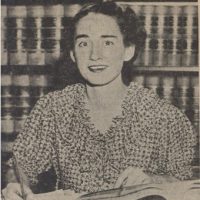

Helen Grigware Lambert’s (1912-1993) early paintings were figurative and rendered in a dark palette. By 1970, her style had become increasingly abstract, with lively colors and passages of white. Thin, delicate lines of dripped paint spread and interlace about the canvas, defining the flowers that had become her subject of choice and that her titles reference.
In addition to being an artist, Lambert was also a lawyer. In 1937, she became the first woman to graduate from the Gonzaga University School of Law in Spokane, Washington. During World War II, she worked at the District Court of Appeals in San Francisco, California, as a clerk for the United States Circuit Court of Appeals judge, while her husband Tom Lambert served in the United States Navy before eventually becoming a Pentagon official and journalist for Time magazine. After moving to Japan to reunite with her husband, she became the only woman prosecutor on the Tokyo War Crimes Trials from 1946-1948; during the trial, she gave a summation of the American case against Japanese chief cabinet secretary Naoki Hoshino. In between living in Europe and Washington, D.C., during the 1950s, she was a London art critic for the Paris Herald Tribune and a noted painter. Lambert also earned her Master of Arts degree from American University in 1968, writing her thesis titled A Visual Theory of Painting. She traveled around the world extensively during her law career, including to Japan, the former Soviet Union, and Israel; those countries left an indelible impression on the evolution of her artistic vision.